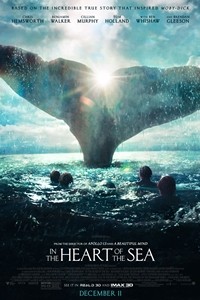 In the Heart of the Sea
In the Heart of the Sea
Directed by: Ron Howard
Starring: Chris Hemsworth, Brendan Gleeson, Benjamin Walker, Cillian Murphy, Tom Holland
By Michael Clawson of Terminal Volume
In the Heart of the Sea is a movie inspired by a book that was inspired by a story that was inspired by a real event. The movie is filmed with a vast array of computer effects and in 3D so gimmicky it belongs in 1955. Somewhere in all this is Moby-Dick and the Essex, a ship that fought a giant whale and lost horribly, but good luck finding them.
The director of the movie is Ron Howard, a national treasure racing toward clumsy mediocrity, who must have watched Mutiny on the Bounty, Master & Commander, Cast Away and Jaws only to say, “We should just combine all these films into one.” What he comes up with is robustly flat period piece that just can’t find its groove.
It stars Thor beefcake Chris Hemsworth as early 19th century whaler Owen Chase, a veteran seafarer who is placed as the first mate to the incompetent dollop of blandness Captain George Pollard (Benjamin Walker), whose daddy takes the family name so seriously it’s remarkable he didn’t name his son Pollard P. Pollard. Chase and Pollard are immediately bickering like an old married couple as they set sail to exterminate every whale in the high seas.
The boat and it’s crew is mostly worthless, except for Chase, who is apparently God’s only gift to sailing. In an early scene, the crew clumsily can’t even unknot a line, but then His Beloved, Chase, jumps into action and heroically saves the day with an act that would have likely caused great division within a real crew. The film seems to be acutely aware that Hemsworth is Thor, and that audiences won’t settle for anything less than an angelic choir of hero worshiping in every scene.
As the boat sails farther from Nantucket looking for whales, it eventually emerges in the Pacific, where the horizon is filled with blowing spouts. The men clamber down into smaller boats armed with spears and rope and off they go to harpoon a species to death. One sperm whale takes great offense to this and single-finedly destroys some of the small boats and then turns his attention to the big ship. He harpoons the side with his whale face, collapses the hull with his whale tail, tears the mast off, and then sets fire to the cargo. This is some Punisher-level revenge here with this bloodthirsty whale.
The crew, clustered into three small dinghies, is left bobbing in the water with little food, water and hope as they splash around 2,000 miles from the nearest land. There is hunger, thirst, suicides, cannibalism, more whale attacks, sickness, disease … a laundry list of bad stuff. Their journey, once all about killing, is now about survival.
From a distance In the Heart of the Sea is dazzling adventure movie, about nature’s pitiless contempt of man’s hubris on the ocean. But step closer to the film and it slowly starts to crumble apart. The cinematography, while incredible in scope, is largely CGI shots with phony lens flare and artificial light. Some wide shots are clearly on the ocean in an actual ship, but much of it was composed on a set with green screen, with the largest concentration of water in the bottles that the cast and crew are drinking from. The characters are thinly written, and often are obscured by beards and dirty makeup. They are given story payoffs that aren’t earned, and thrown together with such haste that a junk drawer has better organization. For instance, Chase and Pollard, at odds with each other the whole film, somehow find an admirable resolution with each other. But why? The film comes to a close before it can tell you.
Scenes with a wife establish Chase as a husband and father, but that goes nowhere. And scenes with Chase and his greedy employer are agonizingly forced, and completely unwarranted, but they’re included because the film needed a villain in capitalism and dishonesty — apparently the ocean, the sun, lack of food and water, and a murderous spree-killing whale weren’t enough in the villain department.
Making matters so much worse is the 3D, which never lets you forget you’re watching a movie with a third dimension. Characters reach into the screen to grab bottles, spears poke out over the audience, foreground objects obstruct shots, the ocean is photographed at low angles to accentuate waves and ocean swells, and rooms are crowded with dangling knick-knacks, all in an effort to transport you into the world of the film. It’s shameless 3D, and entirely unnecessary.
One part of the film I haven’t yet told you about is the story device: the tale of the Essex is told by the last surviving crewmember (Brendan Gleeson) to a young Herman Melville (Ben Whishaw), who is determined to gather information for his next book, the great Moby-Dick. I sorta enjoyed these scenes, particularly Gleeson and Michelle Fairley, who plays his wife. But here’s a letdown: these scenes never happened, and Melville only read stories about the Essex.
Ron Howard needs smaller films, more personal films. And when someone suggests 3D or CGI, he should throw the screenplay at them. If he had the ferocity of this whale, there would be no stopping him.









